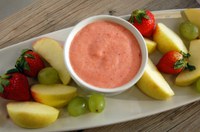Prairie Fare: Prevent Accidental Poisoning in Your Home
(Click an image below to view a high-resolution image that can be downloaded)
By Julie Garden-Robinson, Food and Nutrition Specialist
NDSU Extension Service
“What was her first word?” my older daughter asked as she held our neighbor’s toddler granddaughter.
“Da-da,” the mother of the toddler replied as she glanced at her husband, who grinned.
“Guess what my first word was,” my daughter said.
I was silently chuckling at this exchange because they probably thought she was going to say, “Mama.”
“My first word was ‘hot’!” she exclaimed.
I can take credit for her first word. She spent a lot of time with us in the kitchen and often reached for things that could have been hazardous. She grasped the concept of “hot” and she pulled her hand away from anything that we said was hot.
I guess I learned that parenting trick from my mother. I’m not sure that it’s the best tip because I still touch things slowly to determine if they actually are hot. On the positive side, I can count on a couple of fingers the times I have burned myself in the kitchen.
Kids can move around a home quickly, and they can get into items that are hazardous to their health unless you take precautions.
I remember our early days of parenting. We had locks on the cupboard doors, and we moved many things to upper cupboards, far from exploring hands.
Most parents are well-versed in child-proofing their homes, and we used to be pretty adept at anticipating potential hazards. If I become a grandmother someday, I will have to relearn the process of child-proofing my home because we have many new cleaning products available.
Toddlers and preschoolers love to explore, and they often put things in their mouth. If they come upon a bottle of medication, laundry detergent packets or bottles containing cleaners, they might taste the contents. About 90 percent of poisonings happen in homes, according to the American Cleaning Institute.
More than half the calls received by most poison centers across the country involve children younger than age 6, according to the North Dakota Poison Control Center. Fortunately, most of the poisonings have mild symptoms; however, children could face severe injuries or death.
Even child-resistant caps on medications and other products are not child-proof. Children can be quite adept at figuring out how to open things.
Sometimes colorful medications, vitamins, shampoos and cleaners can look like foods or beverages to a child. Never refer to medication as “candy.” Keep all these items out of children’s reach, and have children ask before they taste to help prevent accidental poisoning.
If children see you taking a prescribed medication or even a multivitamin, they may want to imitate you. Keep medications far from their reach. Even child vitamins can be poisonous.
According to a 2015 survey conducted by the American Cleaning Institute with 1,000 parents and caregivers, more than 80 percent of parents think their child can’t reach laundry packets and 69 percent do not lock the packets in a cupboard. In fact, 3 million households with kids younger than age 4 store laundry packets on top of washing machines.
Pets also can be poisoned by household items, so be sure to keep potentially hazardous items away from them, too.
Here are some important reminders from the American Cleaning Institute for all of us, regardless of whether we have children in our households:
- Read and follow label directions on any chemical, such as laundry detergents, pesticides and household cleaners, in your home, garage or other storage area.
- Store chemicals away from food and in an area not accessible to children and pets.
- Keep the products in their original containers with the labels intact. The chemicals list emergency procedures in case you get the chemical on your skin or in your eyes, or if the chemical is ingested.
- Watch out for buckets of cleaning solutions. Children and pets may be curious to taste the contents.
- Close all chemical containers, especially those with child-resistant caps.
- Do not mix cleaning products. Some produce dangerous fumes.
- Do not reuse empty cleaning containers because the label instructions and precautions for the original product may be inaccurate or dangerous. For example, avoid reusing these containers for craft materials because it can send the wrong message to kids.
For more information, contact your local poison control center. North Dakota has a state poison control center, accessible at http://www.ndpoison.org/index.htm. It includes a variety of educational materials. Add the phone number of your poison control center to your cellphone contacts.
Here’s a tasty fruit dip that kids can help prepare. Keep in mind that any fruit served to kids should be appropriately sized for their age and ability to chew. We want children to enjoy fruits, but some can be choking hazards. See https://www.ag.ndsu.edu/food/food-safety/pregnancy-infants-children for more information about children and food safety.
Refreshing Fruit Dip
1 (16-ounce) package frozen peaches, thawed
1 (10-ounce) package frozen strawberries, thawed
1/2 c. honey nonfat Greek yogurt
1 Tbsp. lemon juice
1/4 tsp. almond extract
Combine all ingredients in a food processor. Blend until smooth. Serve with fresh fruit, such as apple slices or strawberries.
Makes 20 servings. Each (1/4 cup) serving of fruit dip has 20 calories, 0 grams (g) fat, 0 g protein, 4 g carbohydrate, 0 g fiber and 0 milligrams sodium.
(Julie Garden-Robinson, Ph.D., R.D., L.R.D., is a North Dakota State University Extension Service food and nutrition specialist and professor in the Department of Health, Nutrition and Exercise Sciences. Follow her on Twitter @jgardenrobinson)
NDSU Agriculture Communication - March 29, 2018
| Source: | Julie Garden-Robinson, 701-231-7187, julie.garden-robinson@ndsu.edu |
|---|---|
| Editor: | Ellen Crawford, 701-231-5391, ellen.crawford@ndsu.edu |



